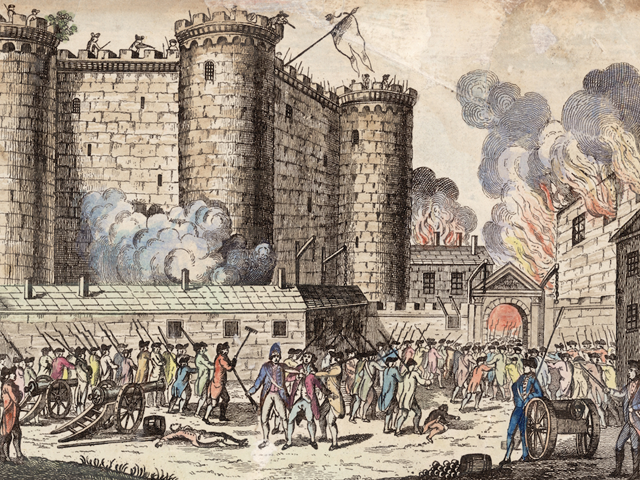Fake news is old news! In a conference on the so-called “French” revolution held in Narbonne on July 14, 2017, historians Marion Sigaut and Claire Colombi pinpoint the kind of fake news promoted by the revolutionaries of 1789, notably the fake news that Parisians were revolting against the monarchy (although they were actually rioters bribed and financed by conspirators who had decided to dethrone the king), as well as the fake news that foreign regiments of alleged “impure blood” were being thrown against the Parisian population. In other words, the lyrics of Marseillaise were already part of the public imagination – lyrics written by Rouget de Lisle, 2 years later, in April 1792.
Excerpt from Marion Sigaut’s part of the conference:
“Everything that happened revolved around Philippe of Orléans, who, from start to finish, completely financed and triggered the riots. The Palais Royal was the headquarters of Philippe of Orleans, Grand Master of the Grand Orient, the absolute leader of freemasonry in France…
On Thursday, July 9, 1789, the abbé Sieyes, Mirabeau, Necker, Bailly (who went on to become the first mayor of Paris), La Fayette, General d’Estaing, and a hundred of their deputy friends from Versailles gathered at Mousseaux (Parc Monceau in Paris) in a property located in northwest Paris… The reunion at Mousseaux took place just a week before the ‘Storming of the Bastille’, and it was there that a plan was set for what would follow. We have documented evidence – writings and testimonies – of what was said at Mousseaux. Philippe of Orléans, who went on to be called Philippe Egalité, had a plan, recounted by the abbé Sieyès as such: ‘Gentlemen, it remains to the French nation only the resource to put itself under the protection of the grand prince who presides over this assembly. So, let us all swear here that we will do everything in our power to lead this immortal prince to the top of the government…’
This textbook example of a conspiracy occurred at the Mousseaux Garden on July 9, 1789, and it was all about overthrowing the throne. Every guest took an oath, upon Sieyès’ request. By dessert, they proclaimed the Duke ‘Regent of the Kingdom’, in a ‘secret consistory’. But all secrets are meant to be broken afterwards, or at least someone will always find a way to do so… That’s how the cover was blown. In the end, people found out about it, and, in response, they undertook to evict the king. A general insurrection in Paris was planned for the Monday, July 13… It was a question of providing for measures of intimidation against the prince’s enemies who could impede on the plan. The prince, being so famous, knew very well that he had enemies in the financial center of Paris. Among his enemies was a certain Flesselles, provost of the merchants (which was equivalent to being mayor), as well as Commissary Bertier, Foulon and Durocher, provosts of the Military Constabulary. From the outset, measures were taken to intimidate such people, who were thought to be enemies of the Duke of Orléans. It was decided that Bailly would replace Flesselles. Bailly would go on to become the first mayor of the Paris Commune. All this was decided at Mousseaux, and was to be accomplished in a few days… It was decided that municipal security would replace Barons Bésenval and Breteuil, who had been responsible for Parisian security… The two senior security officers in Paris were to be eliminated… The goal was to proclaim Philip as ‘Regent of the Kingdom’ and create a “bourgeois guard.” It was now a question of arming Parisians who agreed with the insurgents.
The people were made to believe that the king’s regiments were ‘foreign mercenaries of impure blood’… It was decided that the population would have to be made to believe that the foreign regiments – the ‘German royal’ and the’ Basel royal’ – were regiments of impure blood comprising ‘ferocious soldiers’ who waved around ‘the flag of tyranny’… Philippe of Orléans’ plans could be found in the lyrics of La Marseillaise two years before they were even written.
[…] So, a proscription list was created, namely, a list of people who had to be eliminated. Four days later, a great majority of these people were indeed eliminated, their heads firmly place atop a stick!… If that’s not a conspiracy, I don’t know what is! It’s a conspiracy: the Mousseaux Conspiracy.
Two groups were formed. One went to the Royal Palace and distributed the proscription list, a list of names of people who had to be assassinated, while the other dispersed itself throughout Paris to spread the following proclamation: ‘for a long time, it has been a question of arming the bourgeoisie of Paris. The moment is more pressing than ever, and I am astonished at the recklessness of the inhabitants. Will they be better defended by foreigners than by themselves? […] Parisians, […] the enemies of the public good are at the gates and are marching against you foreign soldiers!’ In other words, they claimed that the king was sending foreign regiments against the Parisian population, which obviously was a lie.
At the same time, crooks were being brought into Paris to disarm the patrols, loot the guard house…
[…] It was rumoured that the Duke would stop the famine and the high cost of living. The Duke had a lot of money. If he were to buy wheat and distribute it, he’d look like a benefactor. The Duke of Orléans was one of those speculators. He made money by selling wheat at a higher price than before the free circulation of food….
At the Hôtel-de-Ville, Philippe of Orléans’ supporters proposed the formation of a “commune” – that is, a municipal government – and of a “National Guard”, to arm the bourgeois.
The king came to understand, through meetings of the King’s Council, at Versailles, that Necker supported Mirabeau’s views and was now an enemy. The king was right: after all, Mirabeau conjured the Mousseaux, and so it made sense that Necker was against the king. Le Chapelier and the Breton Club, a future Jacobin club, understood what was happening. Out of fear, they threatened to denounce the conspirators and all the people involved in turning the Estates General into a (so-called) ‘National Assembly’… don’t agree. In hindsight, the Duke of Orléans did not find all the people he wanted to mobilize.
On July 11, 1789, at 9 PM, Danton was with Choderlos de Laclos (Philippe of Orléans’ agent) at a local café near the Palais Royal. Mirabeau arrived, totally pale, and said that he went to the Champs de Mars, where he found 8 to 10,000 men commanded by Bésenval, who, according to him, were not at all won over to the propaganda: they had not let themselves be fooled by the money that was being offered to them… nor the girls being sent to them. He thought he could count on a change of heart by the soldiers of the Champs de Mars, which, of course, did not happen, as they were not all won over to propaganda. So, he announced a plan submitted to him by the ‘counter-revolutionaries’. He claimed he had come from Versailles, where he had been given the plan that the counter-revolutionaries had worked out at Versailles. He had written the plan in question with Danton! He said that the ‘counter-revolutionaries’ at Versailles (namely, the king and the government), wanted to dissolve the ‘National Assembly’, so as to to arrest all its members, as well as those of the assembly of electors in Paris. He announced that if the people took over the Invalides thinking they could seize weapons, – because the Invalides was also an arsenal – then law enforcement would be ordered to “fire at the people”… At the same time, the Champs de Mars would vomit its columns of troops on Paris, and the Royal German, along with Lambesc, will spread in Paris and will slay the women and children. This is the plan prepared by The King, according to the two people who had invented it all: Mirabeau and his friend Danton. The city would be razed to the ground and handed over to 6,000 brigands. The voters of the Paris municipal council would be hanged. There was an urgent need to print and distribute this news, this fake news… It was printed and broadcasted in Paris! […] At 11 PM, we learned that the King sent Necker away. They didn’t know before, they didn’t have a phone. Mirabeau and Danton’s fake news was already circulating. Paris was convinced that the King was preparing a bloody coup against the city…”
Second part of the conference. Claire Colombi:
“The Republic has been spreading all kinds of lies!”
In this second part, Claire Colombi discusses the economic and financial reasons that led Freemasons to make the ‘Storming of the Bastille’ a national holiday:
“Here’s maybe why, inside the lodge, they decided that the Storming of the Bastille would become our national day: the Bastille was built by King Charles VI, the father of Joan Of Arc’s successor, Charles VII, because in the middle of the fourteenth century, Etienne Marcel, provost of the merchants, had led a Parisian revolt of the corporations and people who already wanted to take power (King Charles VI, very young, had gone to Flanders to fight in the Hundred Years’ War) and they had decreed a kind of Paris Commune for a few weeks (it lasted two months). They demanded that the king no longer pass tax bills or make budgetary decisions without the agreement of the Paris Commune, and the king was deprived of the right to mint coins. In other words, in 1350, when some guys wanted to take power, they’d appropriate for themselves, and themselves only, the right to issue currency and to decide how much will be drawn from it. They decided that they would control the printing press… That was in 1350. The methods haven’t evolved much!
And as it turns out, Etienne Marcel currently has a statue, because, in 1880, the Republicans erected a statue of him next to the Hôtel-de-Ville. Terrified of what had happened, Charles VI built the Bastille to protect himself from the Paris Commune.”
Source in French: http://christroi.over-blog.com/2017/09/la-revolution-dite-francaise.html

